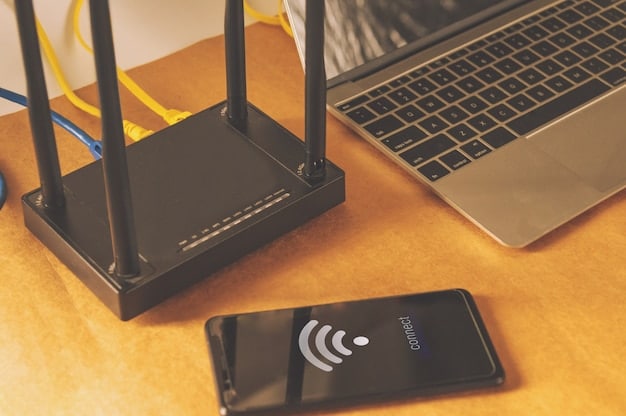Troubleshooting Smart Home Network Issues: Your Practical Guide

Troubleshooting common smart home network issues involves systematically diagnosing and resolving problems such as connectivity drops, slow speeds, and device malfunctions to ensure seamless automation and control within your home.
Experiencing issues with your smart home setup? This guide provides a practical approach to troubleshooting common smart home network issues, ensuring your devices work seamlessly together.
Understanding Your Smart Home Network
Before diving into troubleshooting, it’s essential to understand how your smart home network functions. This foundational knowledge will help you pinpoint the root cause of any issues you encounter.
Key Components of a Smart Home Network
Your smart home network comprises several key components that work together. Understanding these components is crucial for effective troubleshooting.
- Router: The central hub that directs traffic between your devices and the internet.
- Smart Hub: Connects and controls various smart devices using protocols like Zigbee, Z-Wave, or Bluetooth.
- Smart Devices: Including lights, thermostats, security cameras, and more, all connected to your network.
- Internet Connection: The gateway to external services and remote access to your smart home.
Common Network Protocols Used in Smart Homes
Different smart home devices use various network protocols. Knowing which protocols your devices use can help in diagnosing compatibility issues.
- Wi-Fi: The most common protocol, used by many devices for internet connectivity.
- Zigbee: A low-power, mesh network protocol ideal for devices with infrequent data transmission.
- Z-Wave: Another low-power mesh network protocol, known for its reliability and range.
- Bluetooth: Commonly used for direct device-to-device communication, often for initial setup.
Understanding these components and protocols will lay the groundwork for effectively troubleshooting any issues that arise in your smart home network. By recognizing how each part interacts, you’ll be better equipped to diagnose and resolve problems, ensuring your smart home operates smoothly.
Identifying Common Smart Home Network Problems
Many issues can plague a smart home network, ranging from simple connectivity problems to more complex device malfunctions. Identifying these common problems is the first step in finding a solution.

Connectivity Issues
One of the most frequent problems is devices losing their connection to the network. This can manifest in several ways.
- Devices Dropping Off the Network: Smart devices intermittently disconnecting from the Wi-Fi or smart hub.
- Inability to Connect New Devices: Difficulty adding new devices to the network, often due to compatibility issues or network congestion.
- Weak Wi-Fi Signal: Poor signal strength in certain areas of the house, preventing devices from connecting reliably.
Performance and Speed Problems
Even when devices are connected, performance issues can significantly impact usability.
- Slow Response Times: Delays in commands being executed by smart devices.
- Buffering Issues with Streaming Devices: Streaming devices experiencing frequent buffering or low-quality playback.
- General Network Slowness: Overall slow internet speeds affecting all connected devices.
Interference and Compatibility Issues
Interference from other devices and compatibility problems can also cause headaches.
- Signal Interference: Other electronic devices interfering with the Wi-Fi or smart hub signals.
- Device Compatibility Problems: Incompatibility between different smart devices or protocols.
- Software and Firmware Issues: Outdated software or firmware causing conflicts or malfunctions.
Identifying these common issues will allow you to focus your troubleshooting efforts effectively. By recognizing the symptoms, you can begin to diagnose the root cause of the problem and implement the appropriate solutions.
Step-by-Step Troubleshooting Guide
Once you’ve identified the problem, a systematic approach to troubleshooting is essential. This step-by-step guide will help you diagnose and resolve common smart home network issues.
Checking Basic Network Connections
Start with the basics to rule out simple connectivity issues.
- Router and Modem: Ensure that your router and modem are properly connected and powered on. Restart them by unplugging them, waiting 30 seconds, and plugging them back in.
- Network Cables: Verify that all network cables are securely connected to the appropriate ports.
- Internet Connection: Check your internet connection by testing it on a computer or other device.
Diagnosing Device-Specific Problems
If the basic connections are fine, focus on individual devices.
- Power Cycle Devices: Unplug the smart device, wait a few seconds, and plug it back in. This can resolve temporary glitches.
- Proximity to Router: Ensure the device is within a reasonable range of the router or smart hub. If not, consider moving the device closer or adding a Wi-Fi extender.
- Software Updates: Check for and install any available software or firmware updates for the device.
Advanced Troubleshooting Techniques
For more complex issues, try these advanced techniques.
- Network Diagnostics Tools: Use network analysis tools to identify potential problems such as signal interference or network congestion.
- Factory Reset: As a last resort, perform a factory reset on the device. Be aware that this will erase all settings, and you will need to set up the device again.
- Contact Support: If all else fails, contact the manufacturer’s support for assistance.
By following this step-by-step guide, you can systematically troubleshoot and resolve many common smart home network issues. Starting with the basics and moving on to more advanced techniques will help you identify the root cause and implement the appropriate solution.
Optimizing Your Wi-Fi Network for Smart Home Devices
A well-optimized Wi-Fi network is crucial for ensuring that your smart home devices function smoothly. Here’s how to optimize your Wi-Fi network for better performance.

Upgrading Your Router
An outdated router can significantly impact your network’s performance. Consider upgrading to a newer model with better features.
- Latest Standards: Choose a router that supports the latest Wi-Fi standards (e.g., Wi-Fi 6 or Wi-Fi 6E) for improved speed and efficiency.
- Dual-Band or Tri-Band: Opt for a dual-band or tri-band router to reduce congestion by distributing devices across different frequency bands.
- Mesh Wi-Fi Systems: Consider a mesh Wi-Fi system for better coverage in larger homes. These systems use multiple nodes to create a seamless network.
Managing Network Congestion
Too many devices on a single network can cause congestion. Here’s how to manage it.
- Quality of Service (QoS): Configure QoS settings on your router to prioritize traffic for critical devices or applications.
- Guest Network: Use a guest network for visitors to keep their devices separate from your primary network.
- Device Limits: Set device limits on your router to prevent any single device from hogging bandwidth.
Securing Your Wi-Fi Network
A secure Wi-Fi network is essential for protecting your smart home devices from unauthorized access.
- Strong Passwords: Use strong, unique passwords for your Wi-Fi network and router admin panel.
- WPA3 Encryption: Enable WPA3 encryption for enhanced security.
- Regular Firmware Updates: Keep your router’s firmware updated to patch security vulnerabilities.
Optimizing your Wi-Fi network will significantly improve the performance and reliability of your smart home devices. By upgrading your router, managing network congestion, and securing your Wi-Fi network, you can ensure a seamless and secure smart home experience.
Dealing with Interference and Range Issues
Interference and range issues can significantly impact the performance of your smart home network. Here’s how to address these challenges effectively.
Identifying Sources of Interference
Many devices can cause interference with your Wi-Fi or smart hub signals. Identifying these sources is the first step in resolving the issue.
- Microwave Ovens: These can interfere with the 2.4 GHz Wi-Fi band.
- Cordless Phones: Older cordless phones may also cause interference.
- Bluetooth Devices: An abundance of Bluetooth devices can clutter the wireless spectrum.
Extending Wi-Fi Range
If your smart devices are located far from the router, you may need to extend your Wi-Fi range.
- Wi-Fi Extenders: These devices amplify the Wi-Fi signal, extending its reach.
- Mesh Wi-Fi Systems: As mentioned earlier, mesh systems provide seamless coverage throughout your home.
- Relocating the Router: Place your router in a central location, away from obstructions and interference sources.
Using Alternative Network Protocols
If Wi-Fi is proving problematic, consider using alternative network protocols for certain devices.
- Zigbee and Z-Wave: These protocols are designed for low-power devices and can operate on different frequencies, reducing interference with Wi-Fi.
- Ethernet: For stationary devices like smart TVs, consider using a wired Ethernet connection for a more stable and reliable connection.
Addressing interference and range issues will improve the reliability and performance of your smart home network. By identifying interference sources, extending your Wi-Fi range, and using alternative network protocols, you can ensure that your smart devices function optimally, regardless of their location in your home.
Maintaining and Updating Your Smart Home Network
Regular maintenance and updates are crucial for keeping your smart home network running smoothly and securely. Here’s how to maintain your network effectively.
Regular Software Updates
Keeping your devices and router updated with the latest software is essential for security and performance.
- Automatic Updates: Enable automatic updates on your smart devices and router whenever possible.
- Manual Checks: Regularly check for updates manually if automatic updates are not available.
- Firmware Updates: Pay special attention to firmware updates for your router and smart hubs, as these often include critical security patches.
Network Security Practices
Implementing strong network security practices will protect your smart home from potential threats.
- Strong Passwords: Use strong, unique passwords for all your smart devices and network accounts.
- Two-Factor Authentication: Enable two-factor authentication (2FA) whenever possible for added security.
- Firewall Protection: Ensure that your router’s firewall is enabled and properly configured.
Routine Network Checks
Performing routine network checks can help you identify and address potential problems before they escalate.
- Performance Monitoring: Regularly monitor your network’s performance using network analysis tools.
- Device Inventory: Keep an updated inventory of all the devices connected to your network.
- Security Audits: Periodically conduct security audits to identify and address any vulnerabilities.
By maintaining and updating your smart home network regularly, you can ensure that it remains secure, reliable, and performs optimally. Routine software updates, strong security practices, and regular network checks will keep your smart home running smoothly for years to come.
| Key Point | Brief Description |
|---|---|
| 🛠️ Check Router | Ensure router and modem are correctly connected and restarted. |
| 📶 Optimize Wi-Fi | Upgrade router, manage congestion, and secure your Wi-Fi network. |
| 📡 Extend Range | Use Wi-Fi extenders or mesh systems to improve coverage. |
| 🔒 Security | Keep software updated and implement strong passwords for security. |
FAQ
▼
Frequent disconnections can stem from a weak Wi-Fi signal, router issues, or interference. Ensure your devices are within range, update router firmware, and minimize interference from other electronics.
▼
Improve speed by upgrading your router, managing network congestion with QoS settings, and using Ethernet for high-bandwidth devices. Regularly monitor network performance and reduce unnecessary connected devices.
▼
Verify device compatibility with your network protocols (Wi-Fi, Zigbee, Z-Wave). Check for software updates, ensure correct network credentials, and try power cycling both the device and the router during setup.
▼
Yes, improperly secured smart devices can be vulnerable. Use strong, unique passwords, enable two-factor authentication, keep firmware updated, and use a separate guest network for less-trusted devices. Regularly perform security audits.
▼
Update router firmware as soon as updates are available, ideally monthly. These updates often include critical security patches and performance improvements. Enable automatic updates if supported by your router model.
Conclusion
By following this comprehensive guide, you can effectively troubleshoot common smart home network issues and ensure your connected devices operate smoothly. Regular maintenance, security updates, and a proactive approach to problem-solving will keep your smart home running efficiently and securely.





